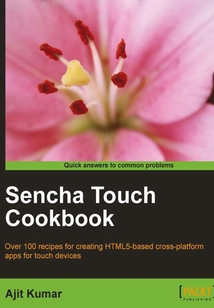舉報 

會員
Sencha Touch Cookbook
最新章節:
Index
Thebookiswritteninacookbookstyle,presentingexamplesinthestyleofrecipes,allowingyoutogodirectlytoyourtopicofinterest,orfollowtopicsthroughoutachaptertogainin-depthknowledge.ThisbookisidealforanyonewhowantstogainthepracticalknowledgeinvolvedinusingSenchaTouchmobilewebapplicationframeworktomakeattractivewebappsformobiles.IfyouhavesomefamiliaritywithHTMLandCSS,thenthisbookisforyou.Thisbookwillgivedesignerstheskillstheyneedtoimplementtheirideas,andprovidedeveloperswithcreativeinspirationthroughpracticalexamples.Itisassumedthatyouknowhowtousetouchscreens,touchevents,WebKitonmobilesystems,AppleiOS,andGoogleAndroidforMobiles.
目錄(140章)
倒序
- coverpage
- Sencha Touch Cookbook
- Credits
- About the Author
- About the Reviewers
- www.PacktPub.com
- Support files eBooks discount offers and more
- Preface
- What this book covers
- What you need for this book
- Who this book is for
- Conventions
- Reader feedback
- Customer support
- Chapter 1. Gear up for the Journey
- Introduction
- Setting up the Android-based development environment
- Setting up the iOS-based development environment
- Setting up the Blackberry-based development environment
- Setting up the browser-based development environment
- Setting up the production environment
- Detecting the device
- Finding information about features that are supported in the current environment
- Initializing your application
- Tweaking your application to configure itself using profiles
- Responding to the orientation change
- Chapter 2. Catering to your Form Related Needs
- Introduction
- Getting your form ready with FormPanel
- Working with search
- Putting custom validation in the e-mail field
- Working with dates using DatePicker
- Making a field hidden
- Working with the select field
- Changing the value using Slider
- Spinning the number wheel using Spinner
- Toggling between your two choices
- Checkbox and Checkbox group
- Text and TextArea
- Grouping fields with FieldSet
- Validating your form
- Chapter 3. Containers and Layouts
- Introduction
- Keeping the container lightweight
- Working with Panel
- Adding items to a container at runtime
- Building wizards using CardLayout
- Panel docking using DockLayout
- Fitting into the container using FitLayout
- Arranging your items horizontally using HBoxLayout
- Arranging your items vertically using VBoxLayout
- Mixing layouts
- Chapter 4. Building Custom Views
- Introduction
- Basic HTML templating using Template
- Using XTemplate for advanced templating
- Conditional view rendering using XTemplate
- Designing a custom view using DataView
- Showing the filtered data
- Responding to the user action
- Chapter 5. Dealing with Data and Data Sources
- Introduction
- Creating models
- Loading the form using a data model
- Working with Store
- Converting incoming JSON data into models using JsonReader
- Converting incoming XML data into models using XmlReader
- Validations in models
- Defining the custom validation
- Relating models using association
- Persisting session-specific data using SessionStorageProxy
- Persisting data using LocalStorageProxy
- Accessing in-memory data using MemoryProxy
- Loading data through AJAX using AjaxProxy
- Sorting of the data
- Data grouping
- Filtering data
- Using a cross-domain URL in your application
- Chapter 6. Adding the Components
- Introduction
- Working with Button
- Creating a sheet of buttons with ActionSheet
- Carousel
- Managing a list of data using List
- Grouping items in a List
- Navigating through a list of data using indexBar
- Working with a list of nested data using NestedList
- Picking your choice using Picker
- Switching between multiple views using SegmentedButton
- Working with Tab panels
- Quicker access to application features using Toolbar
- Creating a new component
- Extending an existing component capability
- Overriding a component behavior
- Adding behavior to an existing component using plugins
- Chapter 7. Adding Audio/Visual Appeal
- Introduction
- Animate me!
- Ding-dong! You have a message!
- Working with videos
- Adding the chart support to your app
- Working with an area chart
- Generating a bar chart
- Creating a column chart
- Showing a group of bars and columns
- Switching between stacked and grouped orientation
- Highlighting and displaying an item detail
- Creating a gauge chart
- Creating a line chart
- Creating a pie chart
- Rotating the pies
- Grouping the pies
- Highlighting a pie
- Using a radar chart
- Using a scatter chart
- Chapter 8. Taking your Application Offline
- Introduction
- Detecting offline mode
- Storing your data offline
- Storing your images offline
- Application caching
- Chapter 9. Engaging Users by Responding to Events
- Introduction
- Handling Touch Events
- Handling Scroll Events
- Handling Tap Events
- Handling Double Tap Events
- Handling TapHold Events
- Handling Swipe Events
- Handling Pinch Events
- Handling Drag Events
- Chapter 10. Increased Relevance Using Geolocation
- Introduction
- Finding out your location
- Auto-update of your location
- Tracking direction and speed
- Hooking up Google Maps with your application
- Working with Google Maps options
- Mapping Geolocation on Google Maps
- Index 更新時間:2021-08-20 15:56:35
推薦閱讀
- 自制編譯器
- DevOps for Networking
- Java游戲服務器架構實戰
- C語言程序設計案例式教程
- MySQL數據庫管理與開發(慕課版)
- 小程序開發原理與實戰
- Learning Unity 2D Game Development by Example
- C語言程序設計
- SQL Server數據庫管理與開發兵書
- “笨辦法”學C語言
- Instant PHP Web Scraping
- Raspberry Pi Robotic Projects(Third Edition)
- Selenium WebDriver Practical Guide
- 程序員必會的40種算法
- Microsoft Dynamics GP 2013 Cookbook
- Django 2.0 入門與實踐
- JavaScript+jQuery交互式Web前端開發(第2版)
- More Effective C++:35個改善編程與設計的有效方法(中文版)
- Learn C# in 7 days
- 深入理解ElasticSearch
- 機器學習實戰
- 3ds Max 2012三維設計能力教程(第二版)
- PHP程序員面試筆試真題與解析
- Learning Python for Forensics
- Getting Started with SOQL
- Java游戲編程原理與實踐教程
- Mastering Linux Shell Scripting
- 數字圖像處理原理與實踐:基于Visual C++開發
- TypeScript 2.x for Angular Developers
- Python編程課

